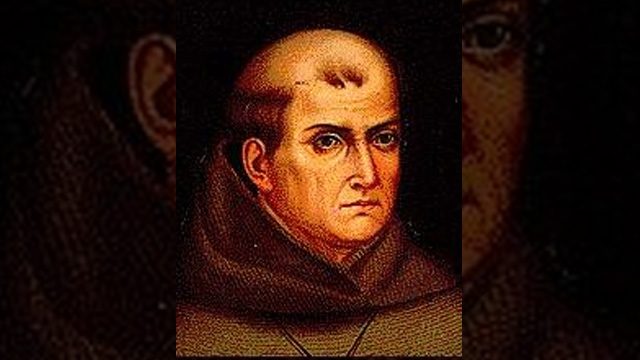SUMMARY
This is AI generated summarization, which may have errors. For context, always refer to the full article.

WASHINGTON DC, USA – The Franciscan friar who brought Christianity to California in the 18th century is on track for sainthood, but for Native Americans, his legacy is anything but holy.
Junipero Serra founded the first 9 of what would become 21 Spanish missions stretching from San Diego to San Francisco, giving the Roman Catholic Church a firm foothold in what was then called New Spain.
Beatified by Pope John Paul II in September 1988, he is set to be canonized when his successor Pope Francis makes his first papal visit to the United States in September.
Serra died in 1784 at the age of 70 at Carmel, the headquarters of his Alta California missions, where he remains interred under the chapel floor.
Among Native Americans, he’s a controversial figure.
They hold him responsible for the suppression of their centuries-old culture and the brutal death of countless thousands of their ancestors.
“We strongly oppose naming the murderer of our people and culture a saint,” said Toypurina Carac, spokesman for the Kizh Gabrieleno nation in greater Los Angeles.
“We are very surprised that a modern, progressive pope like Francis would follow through on this, without doing his homework on the history of Serra and his true legacy,” he told Agence France-Presse.
Ron Andrade, director of the Los Angeles city and county Native American Indian Commission, acknowledged that Serra himself never personally killed anyone.
“But then, neither did Hitler,” said Andrade, referring to what he called the “genocide” of California’s indigenous peoples.
‘Ethnic cleansing’
An online petition, launched by Carac on the liberal website MoveOn.org, appealing to Pope Francis not to canonize Serra, has drawn more than 3,100 signatures.
“It is imperative he is enlightened to understand that Father Serra was responsible for the deception, exploitation, oppression, enslavement and genocide of thousands of indigenous Californians, ultimately resulting in the largest ethnic cleansing in North America,” the petition states.
A Jesuit who is spiritually close to Saint Francis of Assisi, founder of the Franciscan order, the pope announced in mid-January, en route to the Philippines, his intention to canonize Serra as “the great evangelizer” of the American west coast.
Pope Francis will visit Washington, Philadelphia and New York, but not California, on his September 22-27 American tour.
Los Angeles Archbishop Jose Gomez hailed the pope’s intentions, calling it a “gift to California and the Americas.”
“It’s wonderful to think that this new saint once walked the road that is now the Hollywood Freeway,” said Gomez in a statement, referring to one of the most traffic-clogged highways in the United States.
He acknowledged that canonization would revive bad memories of Indian suffering in missionary and colonial times, but recalled an apology that Pope John Paul II extended to native Americans in 1992.
Serra’s name appears widely in California, on street signs and schools, and even on a mountain – the 5,857 foot (1,785 meter) Junipero Serra Peak in Monterey County.
‘A short temper’
University of California at Riverside history professor Steven Hackel, author of Junipero Serra: California’s Founding Father, described the monk as “a very controversial figure even in his own day.”
“Many loved him and many found him impossible,” Hackel told Agence France-Presse.
“He could have a short temper. He was very strong willed. When he believed something was right, he believed it was God’s plan.”
Born on the Spanish island of Majorca, Serra, a noted theologian, travelled first to Mexico before he founded, in San Diego in 1769, the first of his network of missions to convert the Indians.
“They were asked to speak a different language,” Hackel said.
“They were frequently told who they could marry. They were told to dress in a certain manner and to stay there (in the mission) and work.”
They also died in large numbers, their immune systems unable to cope with illnesses that the Europeans brought with them.
According to Hackel, one Indian baby in three did not live longer than a year, and two in five died between the ages of two and four.
Elias Castillo, author of A Cross of Thorns: the Enslavement of California’s Indians by the Spanish Missions, said the Catholic outposts were veritable “death camps.”
They were places, he said, where 62,000 Indians perished as a result of brutality, illness or malnutrition, out of a total indigenous population of 300,000.
“Serra took upon himself that he would simply enslave the Indians,” Castillo told Agence France-Presse. “He had no order to do that.”
Taking an opposing view, Gregory Orfalean, author of another biography about Serra, said the missionary “often risked his own life for the Indians.”
“He often fought with his Spanish overlords in the government and military and advocated strongly on behalf of the California Indian,” he said.
The dramatic 80% drop in California’s indigenous population came later, he said, at the time of the mid-19th century gold rush, more often at the hands of white settlers than a result of disease. – Rappler.com
Add a comment
How does this make you feel?
There are no comments yet. Add your comment to start the conversation.